Hybrid Copyright Attribution in AI-Generated Content
With the help of artificial intelligence, we now have better ways to make literature, photographs, and different types of media. Because of this new technology, it is becoming difficult to determine who owns the copyright on work made by AI. Using HitPaw VikPea and AI, artists have more options to edit and improve their photos, which raises questions about who really owns the changed work. Creating separate approaches for hybrid copyright attribution is important to artists, developers, and people working in law, as it's not always easy to identify if AI was involved in producing the work
Part 1: What is Hybrid Copyright
Hybrid Copyright's Definition and Key Characteristics
It deals with issues of ownership that appear when humans and artificial intelligence combine to create something. It is important to consider the following features: it accepts credit from people as well as technology for the work produced.
Researchers have confirmed that AI art copyright concerns show that, for an AI image to be creatable, someone must still be the original author; AI can't act on its own.
Three Common Scenarios: Complicated Copyright Ownership in AI-Generated Content
Scenario 1: Photographer's Raw Image plus AI Restoration
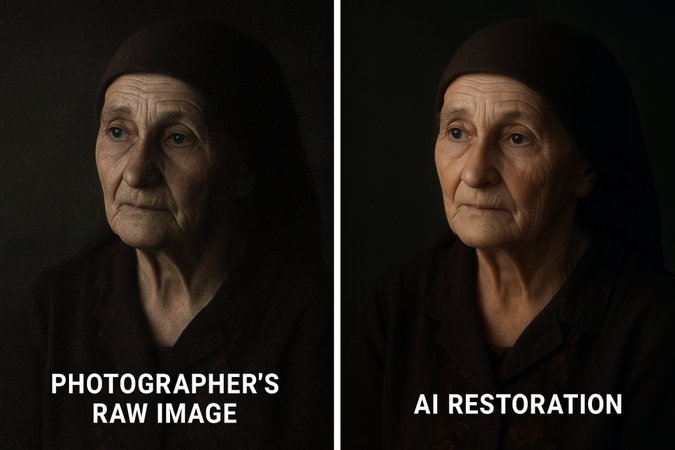
Here a human photographer utilizes their originality, ability, and personal style to produce an original picture. All human-driven aspects have the composition, theme selection, and purpose. Later, artificial intelligence technology helps to improve the image by removing noise, altering illumination, or repairing broken components. The photographer retains complete copyright since the artificial intelligence just improves technical features rather than provides its own expression. Like editing in Lightroom or Photoshop, the artificial intelligence acts as a post-processing device.
Scenario 2: Writer's Prompt plus AI-Generated Tale
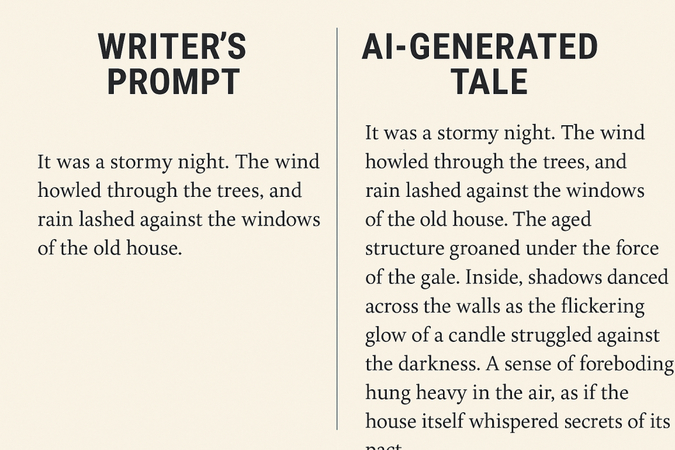
Here a human gives a text prompt; the artificial intelligence then produces a whole article or tale depending on that input. The prompt may direct tenor, theme, or structure, but the finished output is mostly computer-generated. Copyright attribution gets complex in such hybrid outputs. Authorship may be asserted if the human radically edits, shapes, or leads the output of the artificial intelligence. On the other hand, if the AI has the upper hand and the human contribution is negligible, the result might not be copyrightable under existing laws, which call for human authorship.
Scenario 3: Artist's Sketch plus AI Colorization

Giving the original idea and outline, an artist hand-draws or digitally creates a black-and-white sketch. An artificial intelligence program then automatically fills in the colors, shading, or textures. The human input, the sketch, is both essential and creative; the AI acts more like a coloring tool. Usually holding the copyright in this cooperative arrangement is the artist, especially if the ultimate image depends mostly on their original design. The AI assistance is viewed as a supplement rather than an own work.
Part 2: Legal Landscape of AI-Generated Content: Current Copyright Law and Limitations
With constant emphasis on human authorship requirements while addressing new collaborative creation models, the legal terrain shows changing techniques across countries.
How Copyright Laws Treat AI-Generated Content
- The United States Copyright Officer equires human authorship for copyright protection. AI-assisted works qualify when enough human creative input exists. AI cannot independently have copyright rights.
- The European Union emphasizes human personality and imaginative decisions in works,; AI instruments serve as tools (such as cameras or paint brushes); copyright protection needs an identifiable human author.
- China's more nuanced approach enables AI-generated content protection under particular situations; acknowledges copyright when significant human involvement exists in the creation process; considers algorithm design, data selection, and creative parameter setting.
Challenges of AI-Generated Content in Attribution and Legal Recognition
Several contributing players include original content producers delivering training data, AI tool providers developing algorithms and systems, developers deploying and customizing AI applications, and end users operating AI tools and making artistic decisions.
They face challenges like:
- Legal gray areas with hardship in distinguishing between primary and secondary contributions
- Complicated applications of moral rights in human-AI partnerships; enforcement difficulties with competing stakeholder claims
- Attribution requirements across various contribution kinds.
Part 3: Defining Hybrid Copyright Attribution in Human-AI Collaborative Creation through Contracts
The most workable answer for defining rights distribution and preventing uncertainty in hybrid copyright ownership is provided by contracts; they set out unambiguous frameworks before conflicts develop.
Why Contracts Are Crucial in Human-AI Collaborative Creation
Primary Advantages: Legal clarity helps to set reasonable expectations in the emerging legal scene. Risk reduction avoids expensive litigation by way of early agreements. Stakeholder clarity clarifies connections between creators, AI suppliers, and users. Business flexibility enables a range of cooperative arrangements and business models.
Key Clauses to Include in Copyright Contracts for Human-AI Collaborative Creation
Main Components of Contracts:
- Ownership of final output: Specify copyright holders in finished works and derivatives.
- AI tool license scope: define allowed uses, content restrictions, and commercial constraints.
- Attribution requirements: Detail recognition obligations for all contributing parties.
- Moral rights protection: Address creator reputation and integrity interests.
- Future usage rights: Establish derivative work creation.
- Transfer and sublicensing: Clarify rights assignment and third-party licensing capabilities.
Part 4: Best Practices for Creators and AI Tool Providers in Hybrid Copyright Attribution of Human-AI Collaborative Creation
Establishing all-inclusive best practices guarantees the protection of intellectual property rights while promoting creativity in cooperative creative contexts.
Best Practices for Content Creators in Hybrid Copyright Attribution
In hybrid human-AI creations, clear documentation is essential. Creators should record their creative input and decisions throughout the process to establish authorship. This is especially important when distinguishing between human originality and AI assistance.
It is important to always read the Terms of Service of any AI tools, which can include clauses regarding ownership or restricting commercial use. A wrong interpretation of these terms may result in unintended rights.
It is always prudent to have written agreements before beginning a joint project. These issues can be avoided by clarifying roles, responsibility, and ownership up front, especially when the work is monetized or exposed to the public.
In cases where the human input in creativity is significant, you may want to copyright the resulting work. Although the AI output in itself might not be secured, the human-guided work is frequently eligible and can be advantaged by the official registration.
Lastly, employ version control or documented workflows to trace edits and AI-suggested modifications. This aids in establishing authorship and assists in legal proceedings just in case.
Best Practices for AI Developers and Service Providers in Hybrid Copyright Attribution
In order to guarantee clarity and justice in AI-assisted content production, it is absolutely necessary to clearly define user rights and the range of service provider claims in the platform's Terms of Service. Especially when artificial intelligence affects the creative process, clear ownership statements avoid conflicts and enable consumers to grasp how their input and outputs are handled.
Moreover, service agreements ought to define appropriate expectations about the nature of artificial intelligence support. This entails telling users whether the artificial intelligence is only under their control or an independent producer of content. Clear dialogue on these dynamics guarantees consumers are fully aware of their rights and obligations while interacting with AI-powered platforms and helps preserve trust.
Part 5: Leveraging HitPaw VikPea in Human-AI Collaborative Creation: A Practical Guide
Professional AI-powered video improvement that preserves unambiguous ownership structures and facilitates strong creative cooperation is exemplified by HitPaw VikPea.
Key Features of HitPaw VikPea
- Upscaling: The process allows you to change the resolution of low-resolution videos to 4K or 8K.
- Enhancement and Sharpening: Blurry or fuzzy videos created by an AI can be improved by sharpening them and making them appear clearer.
- Colorization: If the AI-made video doesn't have color, HitPaw VikPea can add it for you.
- Removing Noise: It is able to take out any abnormalities and noise in AI-produced videos.
- Background Removal: You can remove the current background and customize any scene behind the main subject in a video, which can be needed for AI videos with unwanted backgrounds.
- Watermark Removal: It can help you get rid of watermarks from AI videos if they are problematic.
This is how HitPaw VikPea can optimize your AI videos.
How to Collaborate with AI Video Enhancer to Upgrade Videos Created by Humans
Step 1: Download and Install
Visit the official HitPaw VikPea website or click the download button to get the authentic installation file. Follow the instructions to install the software on your computer.
Step 2: Upload the Original Video
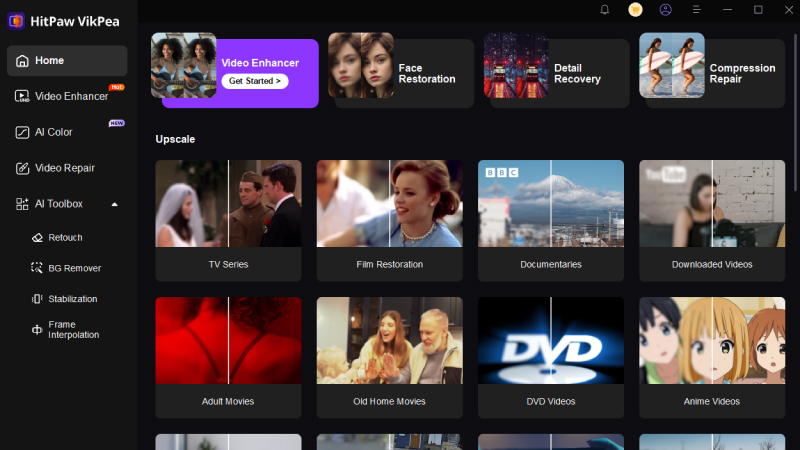
Launch HitPaw VikPea and import the video you want to upscale. You can either click "Choose File" or drag and drop your video into the program. It supports over 30 input formats, including MP4, AVI, MOV, MKV, and M4V.
Tip: If the video contains AI-generated elements, maintain a clear record of the original content and its sources. This helps assert ownership or collaborative authorship under hybrid copyright frameworks.
Step 3: Select an AI Model
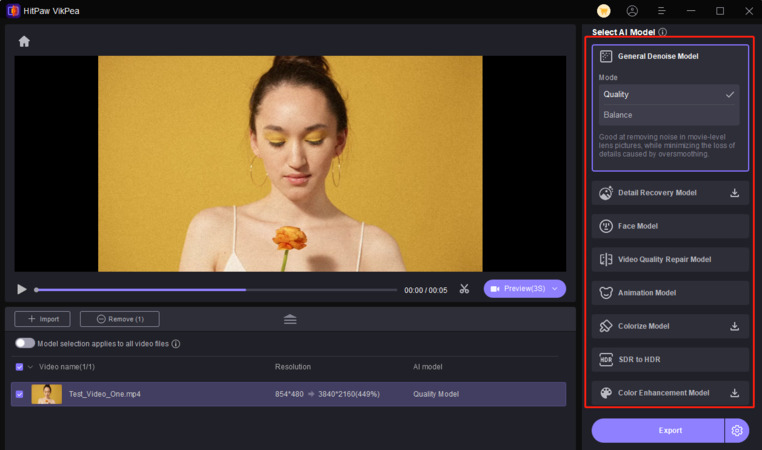
Choose the most suitable AI model based on your video type and enhancement needs: such as General Denoise Model, Face Model, and etc. If you want to learn more about the specific features of the AI video enhancement model, please check out the HitPaw VikPea Guide.
Legal Tip: When using AI tools, check whether the model's usage complies with copyright attribution norms. Ensure your usage agreement or license allows you to publish the AI-enhanced results, especially if used commercially.
Step 4: Preview the Effect & Export
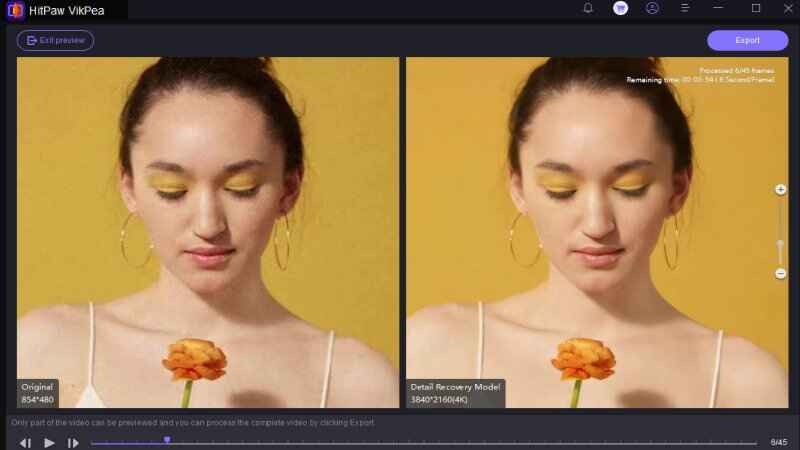
Click the "Preview" button to process your video. After reviewing the result, hit "Export" to save your enhanced video.
Contract Tip: If the video includes collaborative AI input (e.g., prompts, generative edits), consider drafting a usage agreement or copyright clause that defines ownership, especially when multiple creators or third-party tools are involved.
Learn how to enhance videos with HitPaw VikPea from this video:
Conclusion
As AI tools grow more advanced, clear copyright frameworks are vital to avoid ownership disputes and support innovation. A hybrid attribution model, backed by legal systems, standards, and contracts, can guide human-AI collaboration. Proactive action today ensures AI-driven creativity thrives while respecting intellectual property in a changing digital world.


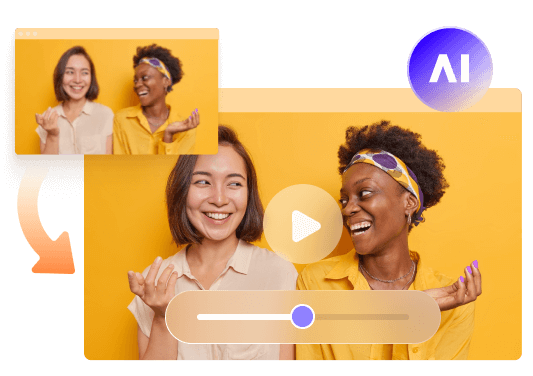




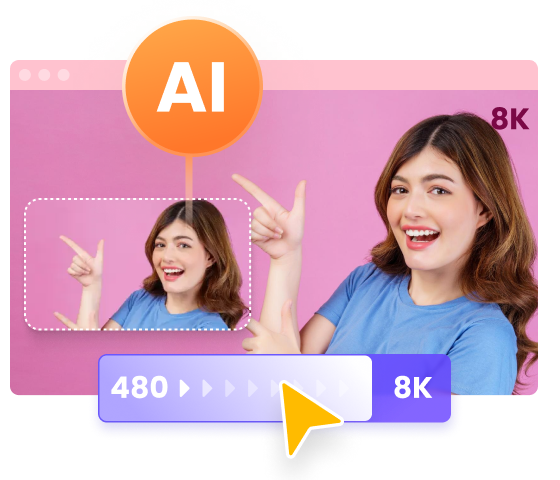
 HitPaw Univd (Video Converter)
HitPaw Univd (Video Converter)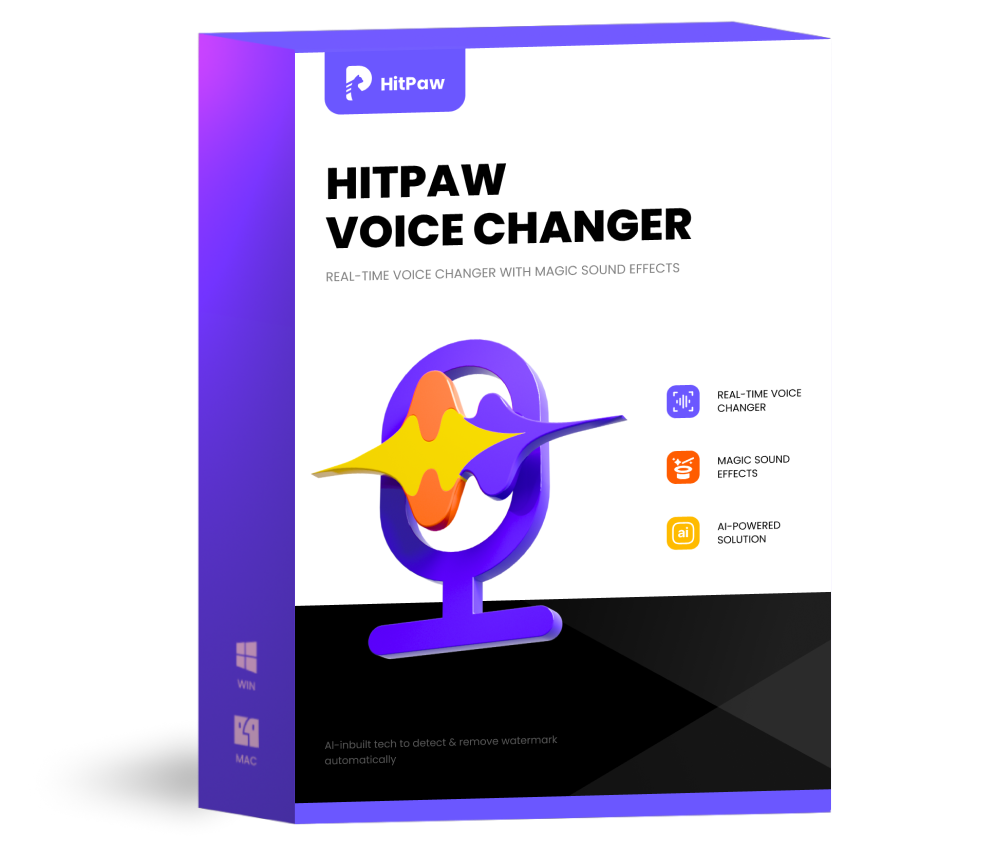 HitPaw VoicePea
HitPaw VoicePea 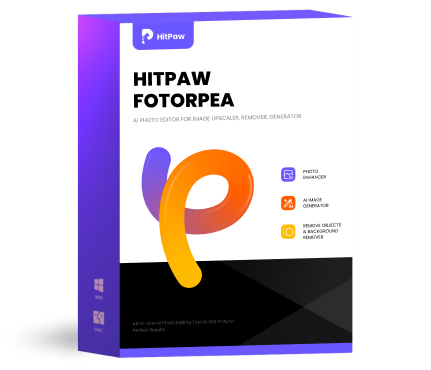 HitPaw FotorPea
HitPaw FotorPea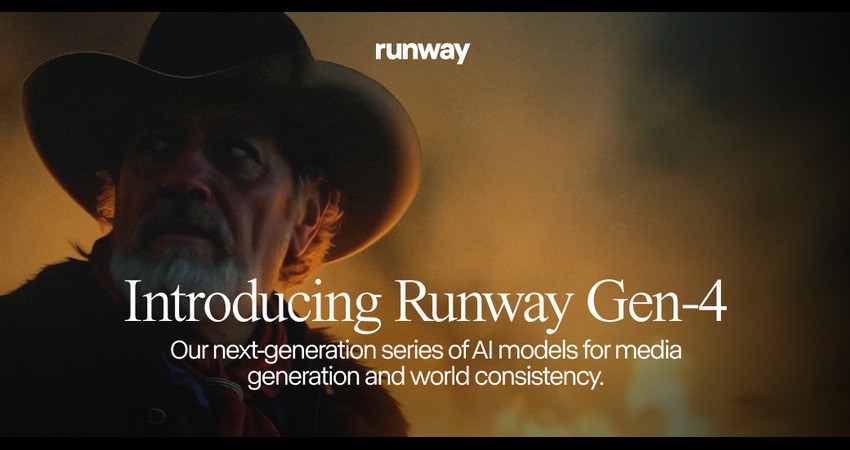
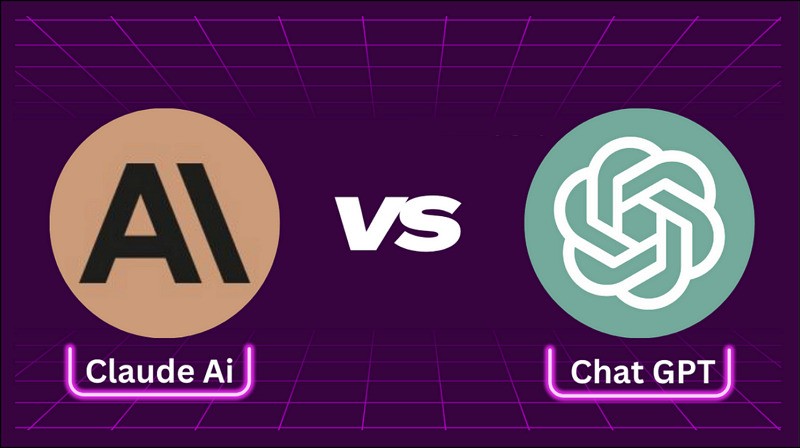


Share this article:
Select the product rating:
Daniel Walker
Editor-in-Chief
This post was written by Editor Daniel Walker whose passion lies in bridging the gap between cutting-edge technology and everyday creativity. The content he created inspires the audience to embrace digital tools confidently.
View all ArticlesLeave a Comment
Create your review for HitPaw articles